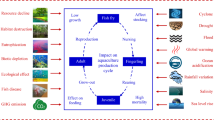Abstract
Cultivation techniques of the marine cold waterspecies turbot (Scophthalmus maximus), Atlantichalibut (Hippoglossus hippoglossus) andAtlantic cod (Gadus morhua) have been developedin Norway during the last decade. Research programshave been undertaken to establish the scientific basisfor a commercial, feasible juvenile productiontechnology.The Atlantic halibut must be carefully maintained inflow through silo systems during their prolongedcritical yolk sac stage (30 days). The period of firstfeeding lasts for approximately 80 days, and copepodsand Artemia are in most cases used as live feed.The halibut larvae have high requirements for n-3HUFA, in particular DHA. More efficient enrichmenttechniques for Artemia and more reliable firstfeeding technology are still major challenges for thisspecies. Commercial production of halibut is still inits early phase, but the numbers produced haveincreased steadily during the last few years, with theexception for 1995. The number of weaned halibut frytransferred to the growout phase was approximately370 000 in 1994 and less than 100 000 in 1995. Theproduction costs range between 5–6 US$ per fry.The rearing technology for juvenile turbot is wellestablished. Turbot larvae are cultured usingclassical intensive rearing techniques withmicroalgae, rotifers and Artemia as live feed.The larval densities are kept rather low by commercialproducers (<5 l-1), but densities inresearch projects are normally much higher (<100larvae per litre). The survival through the larvalstage is normally both predictable and relatively high(10–50%). Improvements in fry quality, e.g. growthpotential and viability, are higher priorities thanimprovement in survival. The number of fry produced inEurope in 1995 was some 2.5 million, anddepended on fry requirements rather thantechnical constraints. Production costs range between1.3–1.4 US$ per fry.The rearing technology of Atlantic cod is similar tothat of turbot, but the dietary requirements of cod,as well as most research objectives, are comparable tothose of halibut. Cod, however, currently has alimited commercial potential. The number of codjuveniles produced in 1995 was approximately 300 000,all produced in poll systems as part of restockingprojects. Established hatchery techniques may beutilized for commercial production of cod juveniles ifthe production costs of cultivated cod is lower thanthe price obtained for wild caught cod.
Similar content being viewed by others
References
Dhert, P., P. Sorgeloos & B. Devresse, 1993. Contribution towards a specific DHA enrichment in the live food Brachionus plicatilis and Artemiasp. In Reinertsen, H., L. A. Dahle, L. Jørgensen and K. Tvinnereim (eds). Proceedings from the International Conference on Fish Farming Technology, Trondheim, Norway, 9–12 August 1993, Balkema, Rotterdam: 109–115.
Harboe, T., I. Huse & G. Øie, G., 1994. Effects of egg disinfection on yolk sac and first feeding stages of halibut (Hippoglossus hippoglossus L.) larvae. Aquacult. 119: 157–165.
Øie, G., K. I. Reitan & Y. Olsen, 1994. Comparison of rotifer culture quality with yeast plus oil and algalbased cultivation diets. Aquacult. Int. 3: 1–14.
Olsen, Y., J. R. Rainuzzo, K. I. Reitan & O. Vadstein. 1993. Manipulation of lipids and ω3 fatty acids in Brachionus plicatilis. In Reinertsen, H., L. A. Dahle, L. Jørgensen & K. Tvinnereim (eds), Proceedings from the international Conference on Fish Farming Technology, Trondheim, Norway, 9–12 August 1993, Balkema, Rotterdam: 101–108.
Reitan, K. I., 1994. Nutritional effects of algae in first-feeding of marine fish larvae. PhD thesis, University of Trondheim, Norway, ISBN 82-90896-16-6.
Reitan, K. I., J. R. Rainuzzo, G. Øie & Y. Olsen, 1993a. Nutritional effects of algal addition in first feeding of turbot (Scophthalmus maximusL.) larvae. Aquacult. 118: 257–275.
Reitan, K. I., J. R. Rainuzzo & Y. Olsen, 1993b. Influence of lipid composition of live feed on growth, survival and pigmentation of turbot larvae. Aquacult. Int. 2: 33–48.
Salvesen, I. & O. Vadstein, 1995. Surface disinfection of eggs from marine fish: evaluation of four chemicals. Aquacult. Int. 3: 155–171.
Skjermo, J., I. Salvesen, G. Øie, Y. Olsen & O. Vadstein. 1997. Microbial maturated water: a technique for selection of a non-opportunistic bacterial flora in water that may improve performance of marine larvae. Aquacult. Int. 5: 13–28.
Stoss, J. H. & J. E. Røer, 1993. Controlled reproduction in turbot (Scophthalmus maximus). In Reinertsen, H., L. A. Dahle, L. Jørgensen & K. Tvinnereim (eds), Proceedings from the International Conference on Fish Farming Technology, Trondheim, Norway, 9–12 August 1993, Balkema, Rotterdam: 29–34.
Vadstein, O., G. Øie, Y. Olsen, I. Salvesen, J. Skjermo & G. Skjåk-Bræk, G. 1993. A strategy to obtain microbial control during larval development of marine fish. In Reinertsen, H., L. A. Dahle, L. Jø8rgensen & K. Tvinnereim (eds), Proceedings from the International Conference on Fish Farming Technology, Trondheim, Norway, 9–12 August 1993, Balkema, Rotterdam: 69–75.
Author information
Authors and Affiliations
Rights and permissions
About this article
Cite this article
Olsen, Y. Larval-rearing technology of marine species in Norway. Hydrobiologia 358, 27–36 (1997). https://doi.org/10.1023/A:1003144309295
Issue Date:
DOI: https://doi.org/10.1023/A:1003144309295




